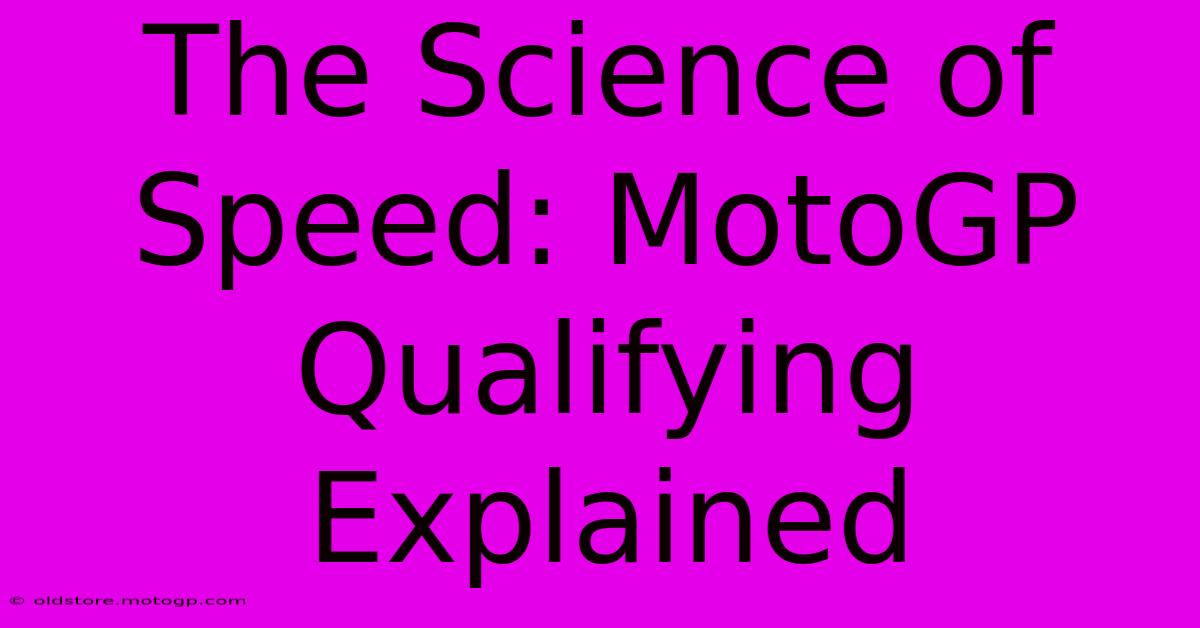The Science Of Speed: MotoGP Qualifying Explained

Table of Contents
The Science of Speed: MotoGP Qualifying Explained
MotoGP, the pinnacle of motorcycle racing, is a breathtaking spectacle of speed, skill, and technology. But behind the roar of the engines and the blur of motion lies a complex science, particularly evident in the nail-biting qualifying sessions. Understanding MotoGP qualifying is key to appreciating the strategic depth and technical prowess that define this thrilling sport. This article delves into the science behind these crucial sessions, exploring the factors that contribute to a rider's success.
The Qualifying Format: A Breakdown
MotoGP qualifying is a multi-stage process designed to separate the fastest riders from the pack. It typically involves:
Free Practice (FP):
These sessions are crucial for riders to familiarize themselves with the track, test different bike setups, and gather data. FP provides valuable information for optimizing tire strategies and race setups. While FP doesn't directly determine grid positions, it's a critical foundation for success in qualifying.
Qualifying 1 (Q1):
The riders with the slowest combined times from the Free Practice sessions start here. Q1 is a fierce battle to secure a place in Q2. Only the top two riders from Q1 progress to the next stage. This stage emphasizes strong one-lap performance, as riders push their machines and themselves to the absolute limit. Tire selection and track conditions are vital considerations.
Qualifying 2 (Q2):
This session features the top 10 riders from the combined Free Practice times plus the two qualifiers from Q1. Q2 is where the fight for pole position intensifies. Riders meticulously analyze the data collected from earlier sessions and make final tweaks to their bike setups. The smallest of margins can separate victory from defeat. The rider with the fastest lap time secures pole position, a significant advantage for the race.
The Science Behind the Speed
Achieving top speed in MotoGP qualifying isn't just about raw power; it's a delicate balance of several scientific factors:
Aerodynamics:
MotoGP bikes are marvels of aerodynamic engineering. Winglets, fairings, and chassis design all play a crucial role in minimizing drag and maximizing downforce, enabling riders to maintain high speeds through corners and on straights. Even the smallest aerodynamic adjustment can significantly impact lap times.
Tire Technology:
Tire performance is paramount. Tire compounds, pressure, and temperature all affect grip, traction, and ultimately, lap times. Teams meticulously analyze weather conditions and track temperatures to select the optimal tire strategy. Tire management during qualifying is a crucial aspect of successful performance.
Engine Performance:
While raw horsepower is essential, efficient power delivery is just as important. Teams continuously work on engine mapping and tuning to optimize power output at different points on the track. Precise throttle control and seamless gear shifts are also vital for maximizing acceleration.
Rider Skill & Fitness:
Ultimately, the human element remains critical. A rider's ability to extract maximum performance from the bike through smooth lines, precise braking, and optimal cornering technique is essential. Physical fitness plays a significant role in maintaining concentration and stamina throughout the grueling qualifying sessions.
Strategic Considerations
Qualifying isn't just about individual lap times. It's also a game of strategy:
- Tire management: Conserving tire life for the race while still pushing for a fast qualifying lap is a constant balancing act.
- Slipstream tactics: Drafting behind other riders can provide a significant speed advantage, especially on long straights. This tactical element adds another layer of complexity to qualifying.
- Track conditions: Changes in weather, track temperature, and even debris can drastically impact lap times, forcing riders and teams to adapt quickly.
Conclusion: More Than Just Speed
MotoGP qualifying showcases a fascinating interplay of scientific principles, technological advancements, and human skill. It's a testament to the relentless pursuit of speed and the intricate strategies employed to achieve it. Understanding the science behind this crucial part of the racing weekend allows for a deeper appreciation of the complexity and excitement of MotoGP. The next time you watch a MotoGP qualifying session, remember that every second counts, and every detail matters.

Thank you for visiting our website wich cover about The Science Of Speed: MotoGP Qualifying Explained. We hope the information provided has been useful to you. Feel free to contact us if you have any questions or need further assistance. See you next time and dont miss to bookmark.
Featured Posts
-
Cota Qualifying Track Conditions And Predictions
Feb 18, 2025
-
Moto Gp 23 Ps 5 Faster Smoother More Realistic
Feb 18, 2025
-
Moto Gp Crash Today Unfolding Drama
Feb 18, 2025
-
Austin Gp 2025 Fasten Your Seatbelts
Feb 18, 2025
-
The Ultimate Party Us Gp Concerts
Feb 18, 2025
